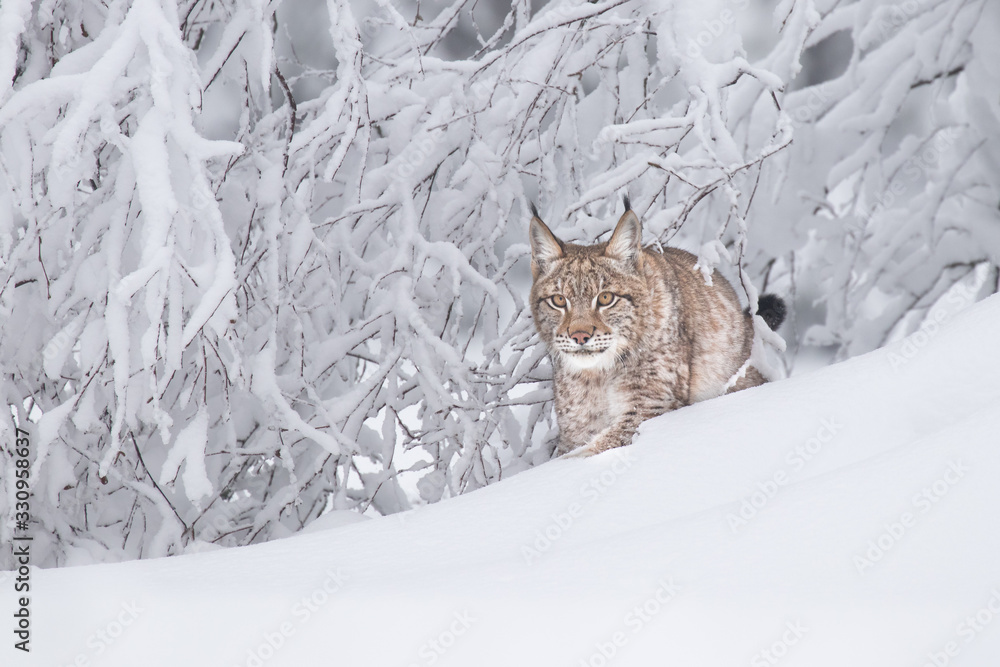Critical Habitat Cut: Critical habitat for lynx slashed as species is functionally extinct in Wyoming

The U.S. Fish and Wildlife Service (FWS) is reducing the amount of critical habitat for threatened Canada lynx in the Greater Yellowstone Area (GYA) of Wyoming by 8,000 square miles.
This is because the lynx population in this region is functionally extirpated – even though a lynx may be recorded every now and then – and the region doesn’t provide necessary habitat conditions.
Lynx habitat
According to FWS, lynx populations estimated at fewer than 25 individuals are considered ‘‘not resilient and functionally extirpated’’ because populations this small are unlikely to persist over time. This is essentially how lynx in the GYA are classified.
There are two things lynx must have to survive – abundant snowshoe hare populations and deep and persistent “fluffy” snow conditions which limit other predators but enables the lynx to successfully hunt its prey.
According to FWS, “Recent habitat modeling which is foundational to this critical habitat revision demonstrated most of the GYA, including areas previously designated as lynx critical habitat, does not contain the physical and biological features necessary to support persistent lynx residency.”
Most of the critical habitat for lynx in Wyoming remains in the Wyoming Range of the Bridger-Teton National Forest, but this area has a slim chance of ever harboring a breeding lynx population.
According to FWS, “It is uncertain whether this unit historically supported a small resident population or if lynx presence and reproduction were and are naturally ephemeral and intermittent. The area currently does not appear to support a resident breeding population.”
Still, the Wyoming Range reportedly has “small pockets of habitat on the Bridger-Teton National Forest in the southern part of the GYA supporting high hare densities.”
FWS estimates the GYA could potentially support a population of 25 to 50 lynx “if sufficient habitat conditions and hare densities could be achieved and maintained, and a resident lynx population is established via translocation.”
But the plan doesn’t anticipate undertaking a translocation either. Instead, the plan tries to conserve potential refugia habitat to preserve future opportunities if necessary to prevent extirpation of lynx in the Lower 48.
Recovery plan
The recently released lynx recovery plan notes lynx populations in the U.S. seem to function as subpopulations or southern extensions of larger populations in southern Canada.
The greatest threat to the species is global climate change, according to FWS, which threatens the long-term conservation of lynx as well as their boreal forest habitats.
The need for proactive forest management is emphasized in the recovery plan.
An updated species assessment conducted by FWS last year stated, “Past vegetation management and fire suppression with dramatic increases in the size, frequency and intensity of wildfires in the western U.S. over the past several decades – exacerbated by climate warming – suggest future vegetation management on federal lands in the West should be guided by a comprehensive lynx habitat conservation strategy which considers climate warming and a wildfire risk and fuel reduction strategy designed to increase forest resiliency and reduce the likelihood of large, high-severity wildfires in important lynx habitats.”
The recovery plan focuses on retaining most existing lynx habitat, calling for no more than a five percent loss of habitat in a 20-year period.
“The five-percent threshold for permanent reductions in lynx habitat applies to anthropo-genic changes to the habitat which convert it to non-forest or convert boreal forest to another vegetation type which does not provide lynx habitat,” the plan notes.
The plan has six focal areas including the GYA, but the GYA is the only focal area which lacks a breeding population of lynx and has no population objective to achieve recovery.
The other focal areas with lynx production are northern Maine and northeastern New Hampshire, northeastern Minnesota, northwestern Montana and northern Idaho and southwestern Colorado.
According to FWS, “The Canada lynx is believed to have evolved from the Eurasian lynx in the last 200,000 years in North America as a snowshoe hare specialist, but with this narrow and specialized ecological niche, lynx likely have little ability to adapt to changing environmental conditions.”
“All aspects of lynx life history are inextricably tied to the snowshoe hare, which comprises most of the lynx diet throughout its range,” the agency reports.
Although lynx are expected to remain listed as a threatened species in the Lower 48 over the next two decades, FWS reports, “Overall, even in a warming climate, the species is not considered to be at risk of extinction, despite uncertainty about how climate change might affect northern lynx and hare populations and cycles and those of other hare predators.”
Cat Urbigkit is a corresponding writer for the Wyoming Livestock Roundup. Send comments on this article to roundup@wylr.net.





